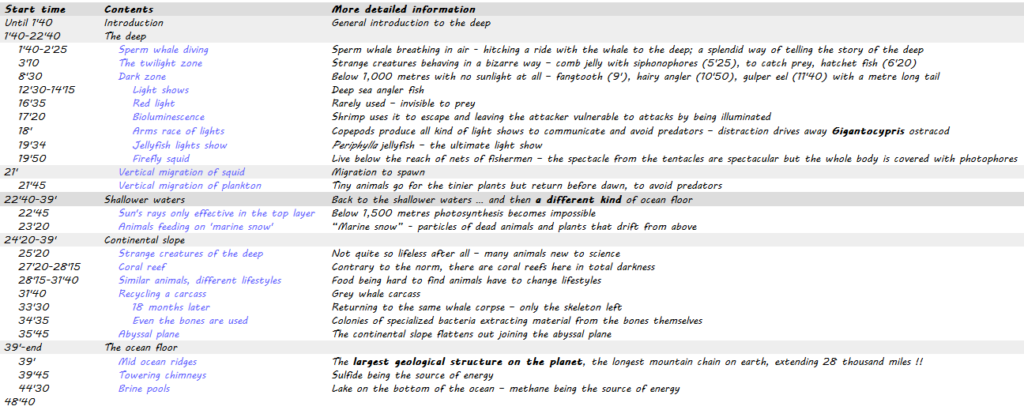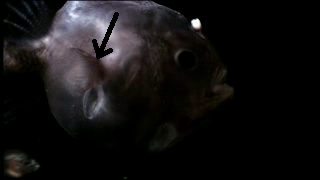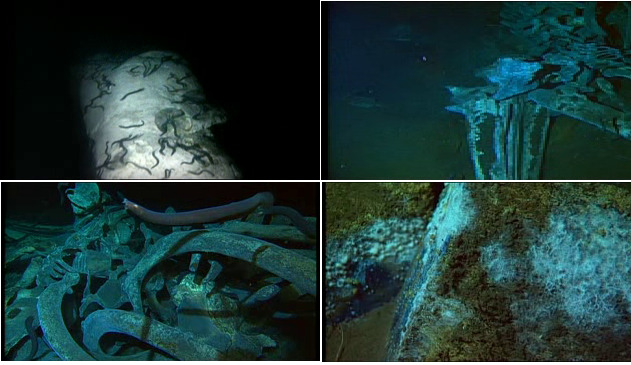Original air date: 19 September 2001


Selected material
A very close relationship
Finding a mate may be even more difficult than finding food. So fish called anglers have their own ways. Male senses chemicals from female and bites permanently into her belly with special teeth. After a while his body has completely fused to hers. She will have permanent access to sperm while her blood circulates in his body, providing him with all the sustenance he will ever need.

Normally the trip to the twilight zone (and the following light show) would have been a very worthy high point of this programme.
Arms race of lights

Ostracods, having enormously big and very light sensitive eyes, prey on copepods (tiny crustaceans). To get away from them the copepods use unusual trickery – light bombs; they emit (top left) material then drifts away for a moment (top right and bottom left) before it explodes some distance away from the crustacean, confusing the ostracod enough to enable the copepod to escape (18’50-18’55).
Coral reefs were not supposed to exist in darkness
Coral reefs found at depths of up to 2 thousand metres in Norwegian fjords. There is much less food available so they have to be more efficient. This leads to them having larger polyps than those in shallower waters so they can catch larger prey.

Similar animals, different lifestyles

At the bottom of the ocean there are familiar animals living completely different lives: sea cucumbers (left) that seek fresh feeding grounds by swimming. The same method is used by polychaete worms (right) that are also mostly known for their bottom living life forms. There are also a few kinds of fish (chimaera, deep sea conger eel and a sixgill (six-gilled or 6 gill) shark) mentioned that are usually predatory but in this case tend to scavenging due to fewer food opportunities.
A whale carcass recycled
The filming of a whale carcass shows how various animal groups and even bacteria co-operate to extract the most out of this gigantic animal.

Life independent of the rays of the sun
To many people the visit to the ocean floor late in the programme was much more arresting. Some 10 minutes into the programme about the natural world in his 60 years series (broadcast in 2012) Attenborough pointed out that the chimneys mentioned here had been discovered by scientists in such places in 1979 (when Life on Earth premiered). This revolutionised knowledge in biology: life wasn’t so dependent on the rays of the sun. Here at the bottom of the ocean, far from the sun’s rays life was thriving, relying instead on energy from hydrothermal vents. More was actually to come, leading to a programme in a forthcoming series “A perfect planet” in 2021 to start with a statement about about volcanoes being a key to life (not the sun as previously believed). This discovery was first treated in the starting episode (Building of the Earth) of The Living Planet series.

Water at these depths (and pressures) can stay as liquid at temperatures as high as 400°C. Bacterial colonies inside mussels are fed sulfide and play the same role as green plants do in the sun.
An ‘underwater lake’
In the Gulf of Mexico there turned out to be a similar wonder. An underwater lake with its own sandy shore was found at the bottom of the ocean. At its edge there seemed to be a tide-line. Turned out to be a thick soup of salty brine – far heavier than seawater – and the ‘sandy shoreline’ was made up of mussels.
